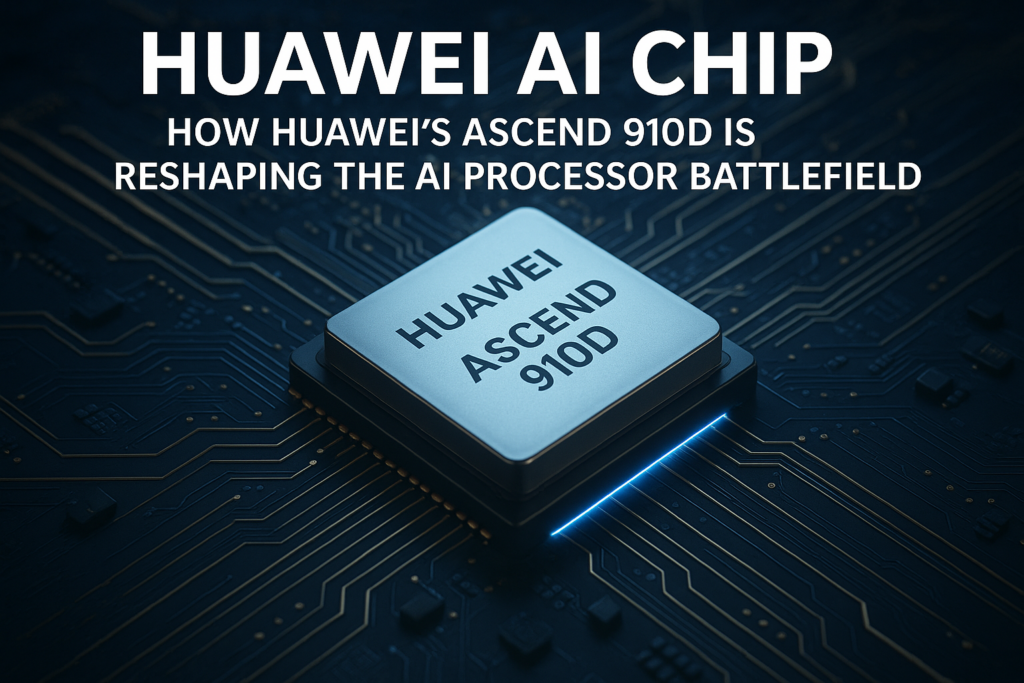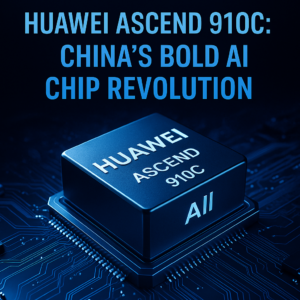Huawei AI Chip: How Huawei’s Ascend 910D Is Reshaping the AI Processor Battlefield
Introduction
Is Huawei taking over Nvidia’s market in the global AI race? Let’s find out!
China’s leading tech brand, Huawei, has launched its latest innovation in AI, Ascend 910, which is already making a powerful statement in the tech market.
Since the world is facing a tight chip sanction from AI and an increasing ban on Nvidia’s H100 in China, Huawei is doubling its development in AI chips and standing strong to position itself as the Next-Gen Huawei Ascend AI Processor. The 910D product by Huawei offers cutting-edge capabilities for AI model training, giving a new ray of hope for Chinese tech companies in seeking independence from the American Tech market.
China’s market is benefiting from its years of expertise and the national policy. Huawei’s innovation is beyond just the chip; it is a strategic response to the Washington Tech Restrictions and redefining China’s AI independence movement.
What is the Huawei AI Chip?
The Huawei AI Chip, specifically the Ascend 910, is an advanced AI technology, a processor designed to train and infer complex AI models. This chip is response to Nvidia H100 and currently the leading global chip in the AI market. The 910D belongs to Huawei’s Ascend series and it surpasses the 910C model by offering improved performance, energy efficiency and ease of features.
Benefits/Importance of Huawei AI Chip
- Enables large-scale AI training models within China.
- Reduces reliance on US tech amid sanctions.
- Supports AI processor testing and scalable AI deployment.
- Fuels Chinese semiconductor innovation and autonomy.
How to Use Huawei AI Chips
Step 1: Integration with AI Training Platforms
Install the Ascend 910D into compatible servers and clusters.
Step 2: Optimize AI Frameworks
Adapt training libraries (e.g., MindSpore) for peak performance.
Step 3: Scale for Mass Deployment
Leverage Huawei’s full-stack AI architecture for enterprise use.
Best Practices & Expert Tips
- Use Huawei’s native AI frameworks for compatibility.
- Ensure cooling systems are optimized—these chips run hot.
- Monitor power efficiency gains versus GPUs like Nvidia H100.
Common Mistakes to Avoid
- Avoid comparing raw specs only—real-world benchmarks matter.
- Don’t ignore Huawei’s proprietary software ecosystem.
- Failure to comply with export controls can risk penalties.
Comparisons: Huawei Ascend 910D vs Nvidia H100
| Feature | Huawei Ascend 910D | Nvidia H100 |
| Availability in China | Yes | Restricted |
| AI Training Support | Optimized | Industry-leading |
| Power Efficiency | High | Moderate |
| Software Ecosystem | Huawei MindSpore | CUDA + TensorRT |
Frequently Asked Questions (FAQs)
Q1. Is Huawei Ascend 910D as powerful as Nvidia H100?
Especially for local workloads in China, this chip is powerful, and it is made to rival the H100 in AI training performance.
Q2. Can Chinese firms use the 910D freely?
There is a massive shipment release of this AI chip, so yes, it is underway and being optimized for domestic deployment as well.
Conclusion
Huawei Ascend 910D’s launch is a response to global tech barriers in China; they are pushing boundaries in AI chip development, and Huawei is flag bearer in this movement. This chip offers powerful alternatives in between a turbulent geopolitical situation. Now that Chinese tech companies are striving for independence, Huawei’s AI chip is making a bold statement with its innovation, ambition and resilience.





